Month-Wise Investigation on Residential Load Consumption Impact during COVID-19 Period on Distribution Transformer and Practical Mitigation Solution
Abstract
:1. Introduction
- Analyzes the month-wise impact of the COVID-19 pandemic on residential loads in Memphis city, Tennessee, USA, mainly from 2019 (pre-COVID-19) period to June 2021 (after COVID-19). In this work, energy consumption data, that are available (from pre-COVID to after COVID-19 conditions) for all months in a year, are investigated comprehensively to confirm the increased energy consumption of four different consumers during office hours to determine the months and time during the office hours to have adverse impact on the transformer which is never studied to the best of our knowledge and can be crucial for future pandemic situation.
- Introduces a practical setup of transformer, and a combination of AC RL load and non-linear DC R-L loads is used to get real time harmonics in currents, and to calculate harmonic loss factor (FHL) and harmonic loss factor for the stray losses (FHL_STR) to determine the detrimental impacts on distribution transformer. Moreover, low voltage passive harmonic filters are proposed as a mitigation solution as it is very useful in reducing the adverse impact of future lockdowns on residential customers and distribution transformers without upgrading the system’s capacity. The effectiveness of using harmonic filter in reducing hottest spot temperature, top-oil temperature, and loss of life is compared with the system having no harmonic filter. Performance comparison of the system with and without mitigation method are carried out through simulation in MATLAB and verified experimentally in the laboratory.
- Provides cost-value analysis of all the possible solutions that can be considered to mitigate the adverse impact on the distribution transformer with a view to providing information to the consumers about the effective solutions.
2. Energy Consumption Analysis of Different Consumers
2.1. Consumer 1
2.2. Consumer 2
2.3. Consumer 3
2.4. Consumer 4
2.5. Comparative Analysis
3. Impacts of Energy Consumption on Distribution Transformer
3.1. Determination of Per Unit Current of Distribution Transformer
3.2. Determination of Harmonic Content in Current of Distribution Transformer
3.3. Calculation of Hottest Spot, Top Oil Temperature of Distribution Transformer
4. Proposed Mitigation Technique
4.1. Filter Design
4.2. Efficacy of the Proposed Mitigation Technique in Hottest Spot, Top Oil Temperature and Percentage of Loss Reduction in Distribution Transformer
4.3. Energy Saving Recommendations
5. Discussion and Conclusions
Author Contributions
Funding
Data Availability Statement
Conflicts of Interest
References
- Bompard, E.; Mosca, C.; Colella, P.; Antonopoulos, G.; Fulli, G.; Masera, M.; Poncela-Blanco, M.; Vitiello, S. The Immediate Impacts of COVID-19 on European Electricity Systems: A First Assessment and Lessons Learned. Energies 2021, 14, 96. [Google Scholar] [CrossRef]
- Bielecki, S.; Skoczkowski, T.; Sobczak, L.; Buchoski, J.; Maciąg, Ł.; Dukat, P. Impact of the Lockdown during the COVID-19 Pandemic on Electricity Use by Residential Users. Energies 2021, 14, 980. [Google Scholar] [CrossRef]
- Bazzana, D.; Cohen, J.J.; Golinucci, N.; Hafner, M.; Noussan, M.; Reichl, J.; Rocco, M.V.; Sciullo, A.; Vergalli, S. A multi-disciplinary approach to estimate the medium-term impact of COVID-19 on transport and energy: A case study for Italy. Energy 2022, 238, 122015. [Google Scholar] [CrossRef] [PubMed]
- Malec, M.; Kinelski, G.; Czarnecka, M. The Impact of COVID-19 on Electricity Demand Profiles: A Case Study of Selected Business Clients in Poland. Energies 2021, 14, 5332. [Google Scholar] [CrossRef]
- Navon, A.; Machlev, R.; Carmon, D.; Onile, A.E.; Belikov, J.; Levron, Y. Effects of the COVID-19 Pandemic on Energy Systems and Electric Power Grids—A Review of the Challenges Ahead. Energies 2021, 14, 1056. [Google Scholar] [CrossRef]
- Ding, T.; Zhou, Q.; Shahidehpour, M. Impact of COVID-19 on power system operation planning. IEEE Smart Grid Newsl. 2020. [Google Scholar]
- Safari, N.; Price, G.; Chung, C. Comprehensive assessment of COVID-19 impact on Saskatchewan power system operations. IET Gener. Transm. Distrib. 2021, 15, 164–175. [Google Scholar] [CrossRef]
- Ruan, G.; Wu, J.; Zhong, H.; Xia, Q.; Xie, L. Quantitative assessment of US bulk power systems and market operations during the COVID-19 pandemic. Appl. Energy 2021, 286, 116354. [Google Scholar] [CrossRef]
- Ghiani, E.; Galici, M.; Mureddu, M.; Pilo, F. Impact on Electricity Consumption and Market Pricing of Energy and Ancillary Services during Pandemic of COVID-19 in Italy. Energies 2020, 13, 3357. [Google Scholar] [CrossRef]
- Bigerna, S.; Bollino, C.A.; D’Errico, M.C.; Polinori, P. COVID-19 lockdown and market power in the Italian electricity market. Energy Policy 2021, 161, 112700. [Google Scholar] [CrossRef]
- Navon, A.; Orda, A.; Levron, Y.; Belikov, J. Effects of Economic Shocks on Power Systems: COVID-19 as a Case Study. In Proceedings of the 2021 IEEE PES Innovative Smart Grid Technologies Europe (ISGT Europe), Espoo, Finland, 18–21 October 2021; pp. 1–5. [Google Scholar]
- Shah, M.I.; Kirikkaleli, D.; Adedoyin, F.F. Regime switching effect of COVID-19 pandemic on renewable electricity generation in Denmark. Renew. Energy 2021, 175, 797–806. [Google Scholar] [CrossRef]
- Santiago, I.; Moreno-Munoz, A.; Quintero-Jiménez, P.; Garcia-Torres, F.; Gonzalez-Redondo, M. Electricity demand during pandemic times: The case of the COVID-19 in Spain. Energy Policy 2021, 148, 111964. [Google Scholar] [CrossRef]
- Alkhraijah, M.; Alowaifeer, M.; Alsaleh, M.; Alfaris, A.; Molzahn, D.K. The Effects of Social Distancing on Electricity Demand Considering Temperature Dependency. Energies 2021, 14, 473. [Google Scholar] [CrossRef]
- Siksnelyte-Butkiene, I. Impact of the COVID-19 Pandemic to the Sustainability of the Energy Sector. Sustainability 2021, 13, 12973. [Google Scholar] [CrossRef]
- Tudose, A.M.; Picioroaga, I.I.; Sidea, D.O.; Bulac, C.; Boicea, V.A. Short-Term Load Forecasting Using Convolutional Neural Networks in COVID-19 Context: The Romanian Case Study. Energies 2021, 14, 4046. [Google Scholar] [CrossRef]
- Bertram, C.; Luderer, G.; Creutzig, F.; Bauer, N.; Ueckerdt, F.; Malik, A.; Edenhofer, O. COVID-19-induced low power demand and market forces starkly reduce CO2 emissions. Nat. Clim. Chang. 2021, 11, 193–196. [Google Scholar] [CrossRef]
- Badesa, L.; Strbac, G.; Magill, M.; Stojkovska, B. Ancillary services in Great Britain during the COVID-19 lockdown: A glimpse of the carbon-free future. Appl. Energy 2021, 285, 116500. [Google Scholar] [CrossRef]
- Ospina, J.; Liu, X.; Konstantinou, C.; Dvorkin, Y. On the feasibility of load-changing attacks in power systems during the covid-19 pandemic. IEEE Access 2020, 9, 2545–2563. [Google Scholar] [CrossRef]
- Elavarasan, R.M.; Shafiullah, G.M.; Raju, K.; Mudgal, V.; Arif, M.T.; Jamal, T.; Subramanian, S.; Balaguru, V.S.; Reddy, K.S.; Subramaniam, U. COVID-19: Impact analysis and recommendations for power sector operation. Appl. Energy 2020, 279, 115739. [Google Scholar] [CrossRef]
- Alam, S.M.M.; Ali, M.H. Analysis of COVID-19 effect on residential loads and distribution transformers. Int. J. Electr. Power Energy Syst. 2021, 129, 106832. [Google Scholar] [CrossRef]
- Strunk, B. The Tech Refresh and the Nega-Watt: Common Sense Powering at Comcast. J. Energy Manag. 2018, 3, 31. [Google Scholar]
- Hafer, M.; Howley, W.; Chang, M.; Ho, K.; Tsau, J.; Razavi, H. Occupant engagement leads to substantial energy savings for plug loads. In Proceedings of the 2017 IEEE Conference on Technologies for Sustainability (SusTech), Phoenix, AZ, USA, 12–14 November 2017; pp. 1–6. [Google Scholar]
- Al-Ali, A.R.; Zualkernan, I.A.; Rashid, M.; Gupta, R.; Alikarar, M. A smart home energy management system using IoT and big data analytics approach. IEEE Trans. Consum. Electron. 2017, 63, 426–434. [Google Scholar] [CrossRef]
- Srinivasan, A.; Baskaran, K.; Yann, G. IoT Based Smart Plug-Load Energy Conservation and Management System. In Proceedings of the 2019 IEEE 2nd International Conference on Power and Energy Applications (ICPEA), Singapore, 27–30 April 2019; pp. 155–158. [Google Scholar]
- Ricardo Energy and Environment. Passive Cooling Technology Recommendations; Ricardo Energy and Environment: Oxford, UK, 2018. [Google Scholar]
- Kurita, N.; Nishimizu, A.; Kobayashi, C.; Tanaka, Y.; Yamagishi, A.; Ogi, M.; Takahashi, K.; Kuwabara, M. Magnetic Properties of Simultaneously Excited Amorphous and Silicon Steel Hybrid-Cores for Higher-Efficiency Distribution Transformers. In Proceedings of the 2018 IEEE International Magnetics Conference (INTERMAG), Singapore, 23–27 April 2018. [Google Scholar]
- Eaton. Power Factor Correction: A Guide for the Plant Engineer; Eaton: Dublin, Ireland, 2014. [Google Scholar]
- Alapera, I.; Manner, P.; Salmelin, J.; Antila, H. Usage of telecommunication base station batteries in demand response for frequency containment disturbance reserve: Motivation, background and pilot results. In Proceedings of the 2017 IEEE International Telecommunications Energy Conference (INTELEC), Gold Coast, QLD, Australia, 22–26 October 2017; pp. 223–228. [Google Scholar]
- Gu, Q.; Ren, H.; Gao, W.; Ren, J. Integrated assessment of combined cooling heating and power systems under different design and management options for residential buildings in Shanghai. Energy Build. 2012, 51, 143–152. [Google Scholar] [CrossRef]
- UC Berkely and C2M. DC Microgrids. 2014. Available online: https://ei.haas.berkeley.edu/education/c2m/2014-c2m-projects.html (accessed on 1 February 2022).
- Hambridge, S.; Huang, A.Q.; Yu, R. Solid State Transformer (SST) as an energy router: Economic dispatch based energy routing strategy. In Proceedings of the 2015 IEEE Energy Conversion Congress and Exposition (ECCE), Montreal, QC, Canada, 20–24 September 2015; pp. 2355–2360. [Google Scholar]



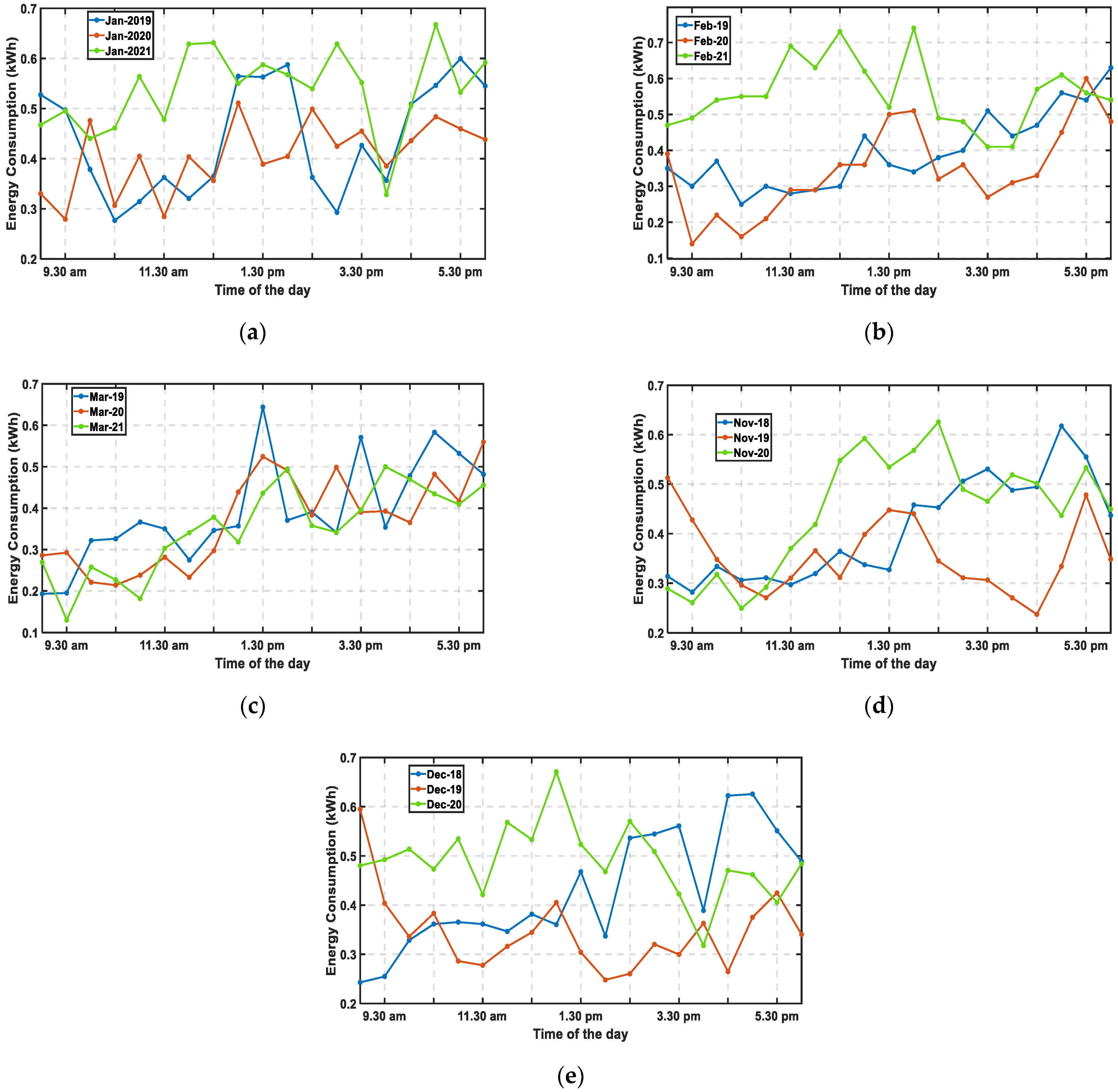
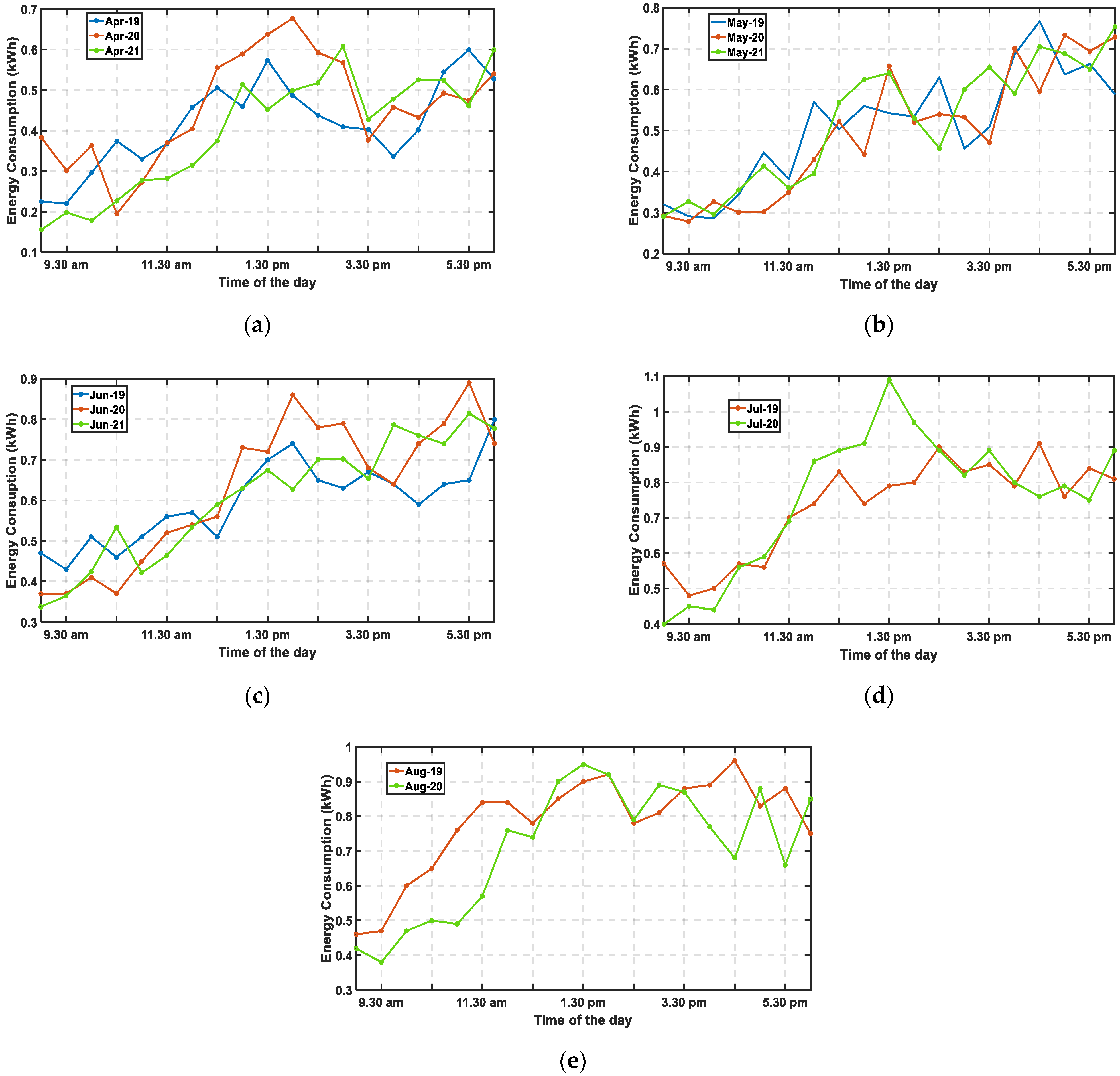


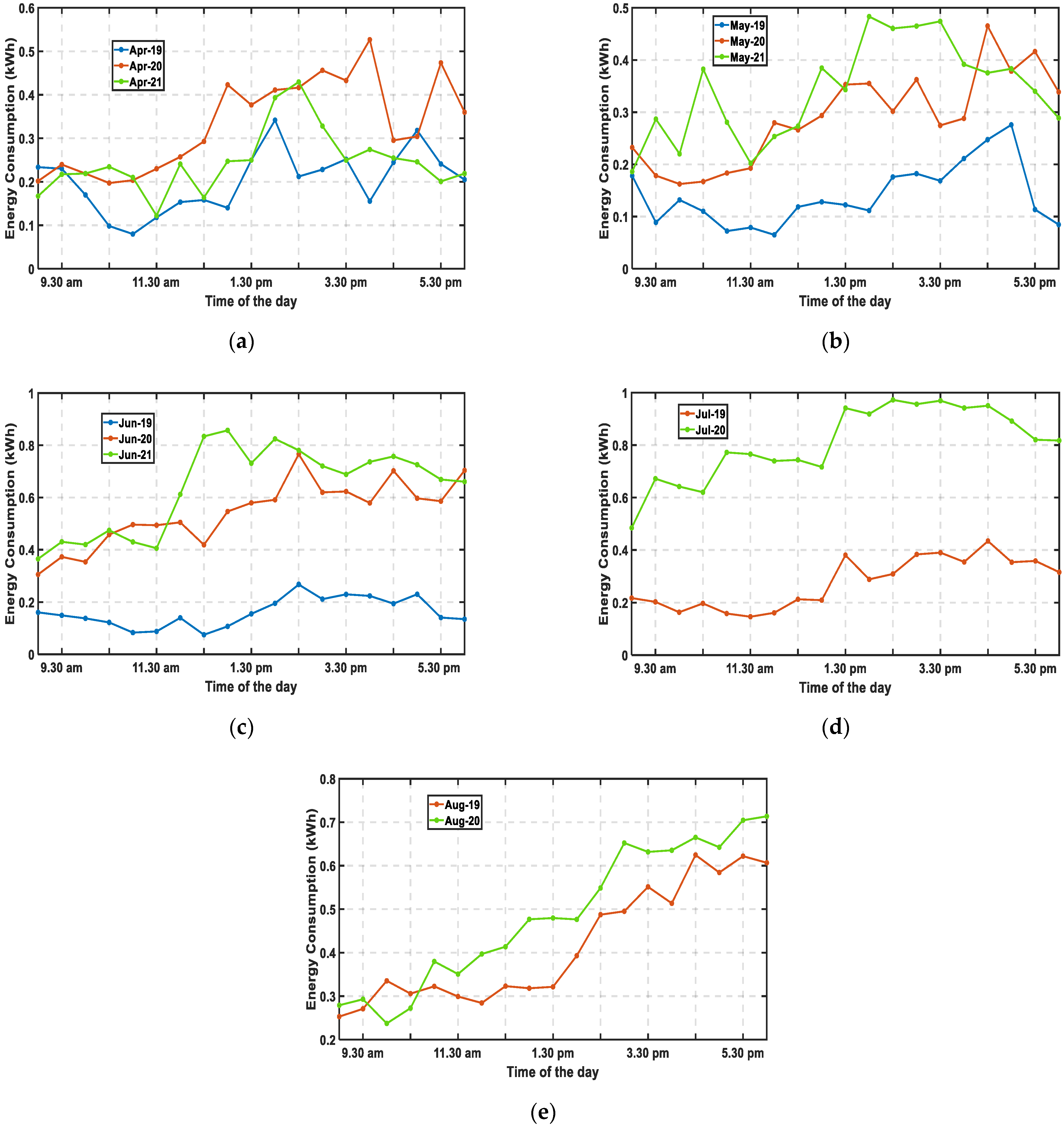

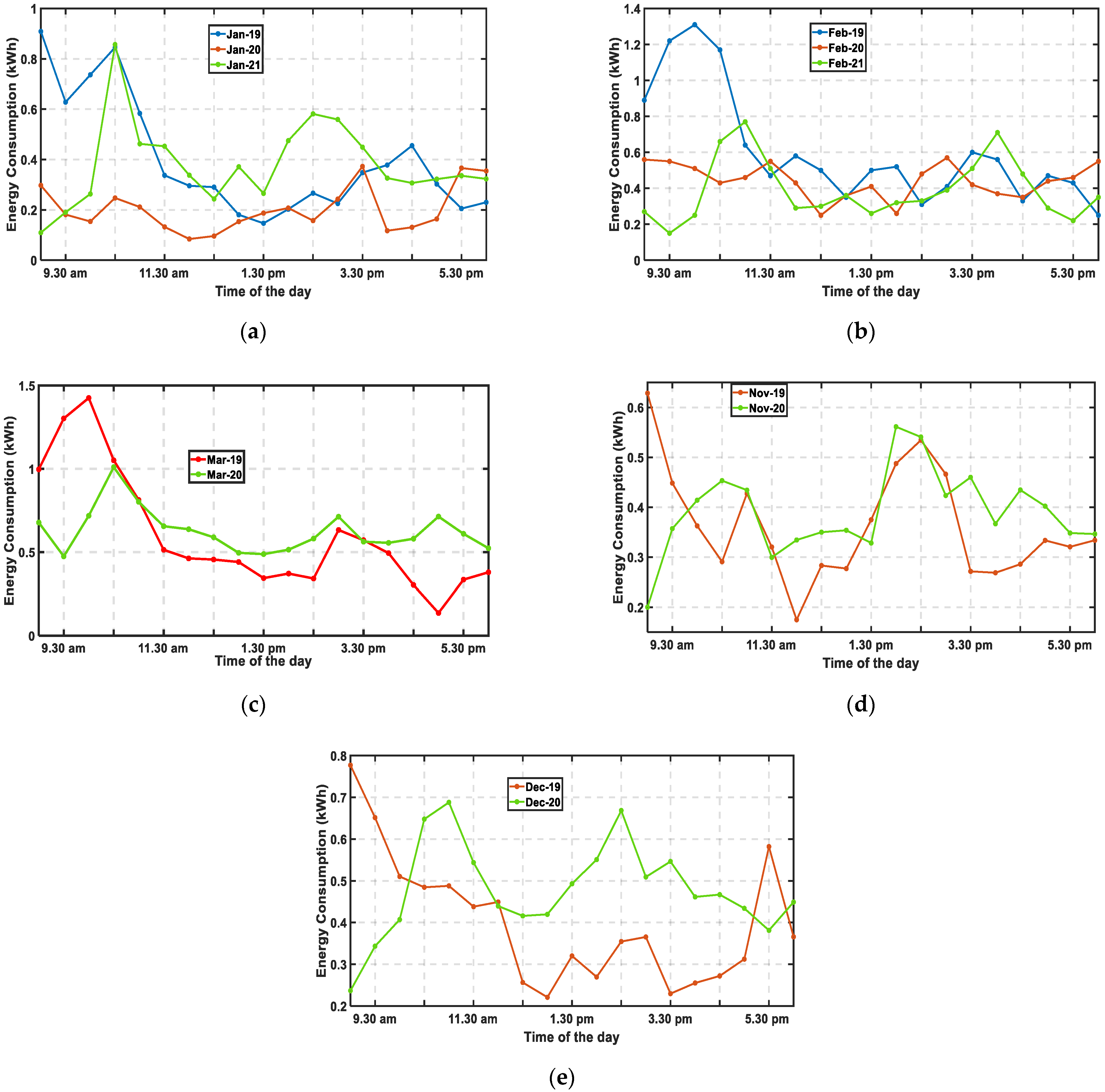
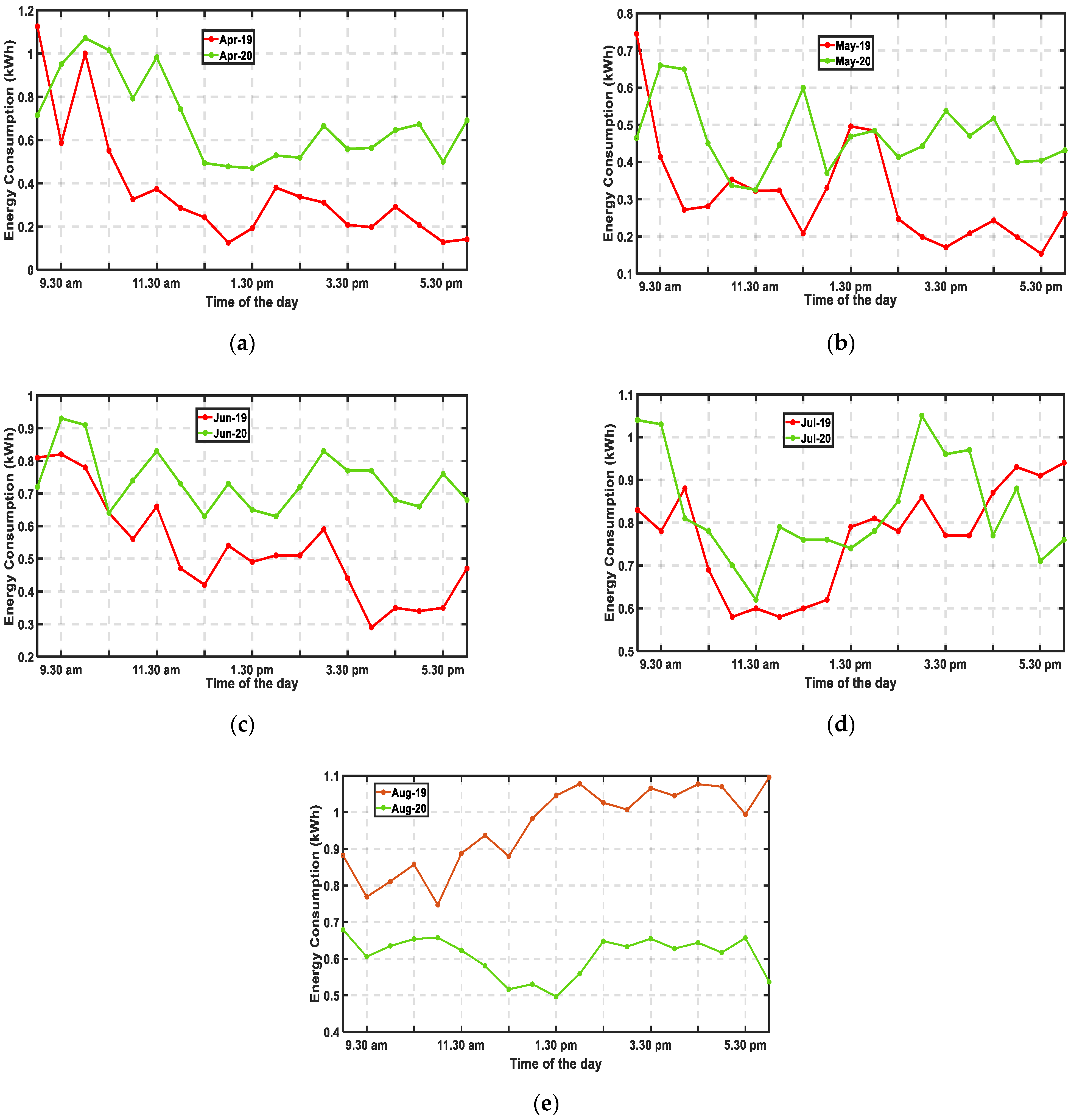
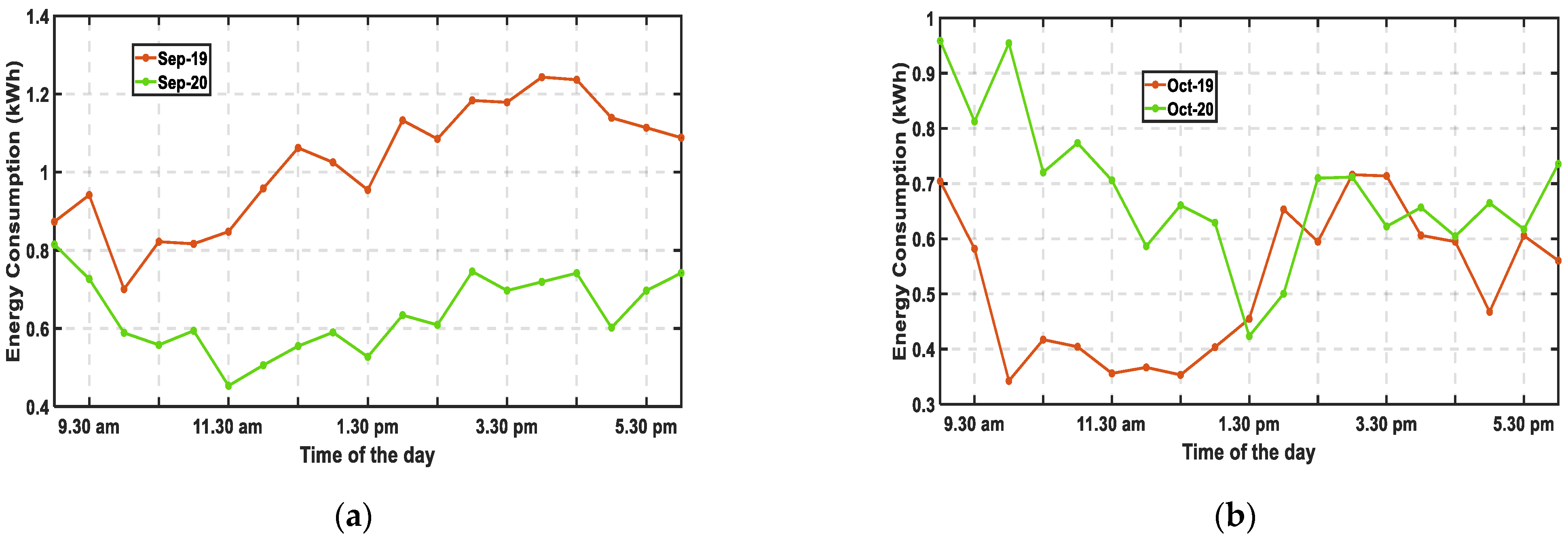

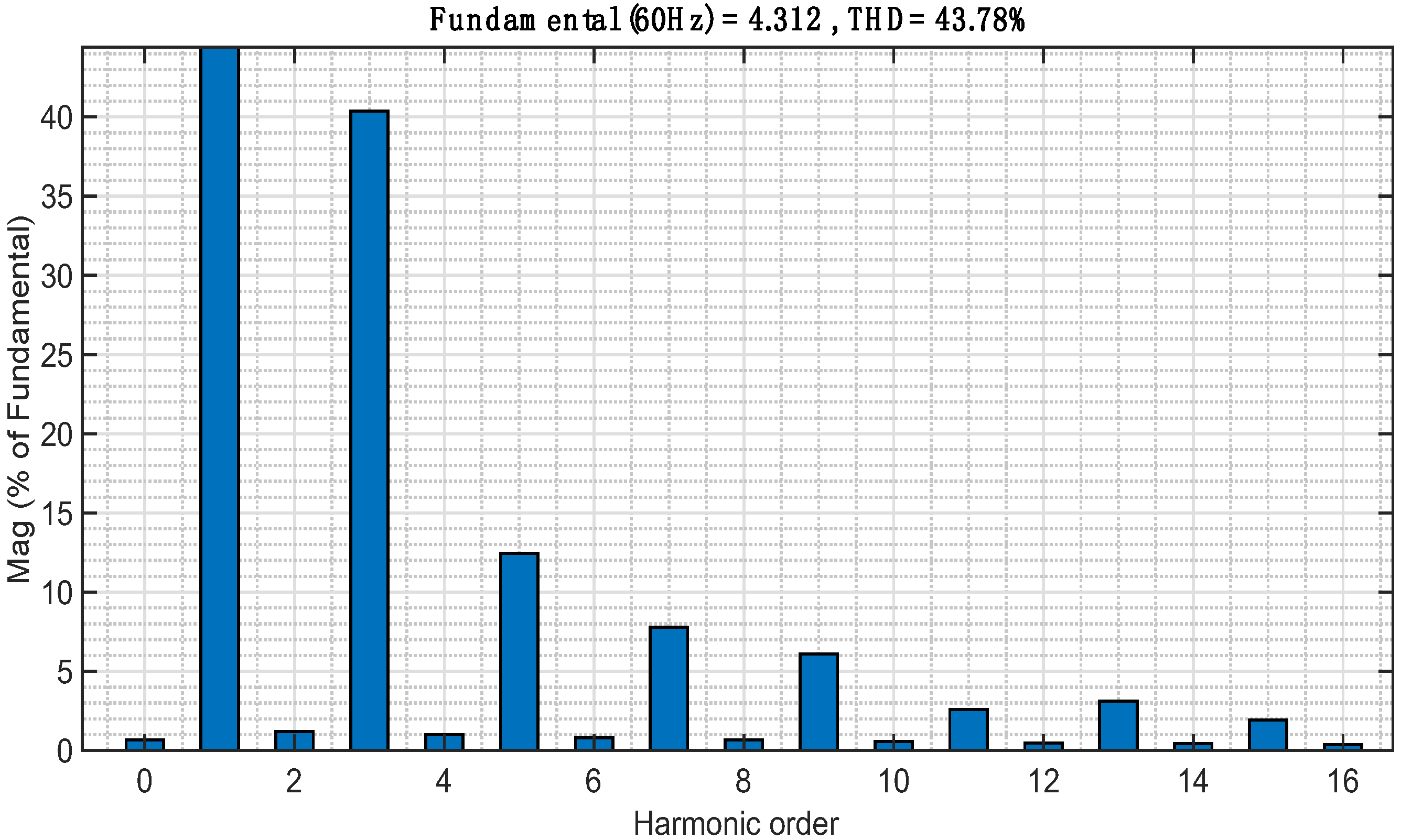

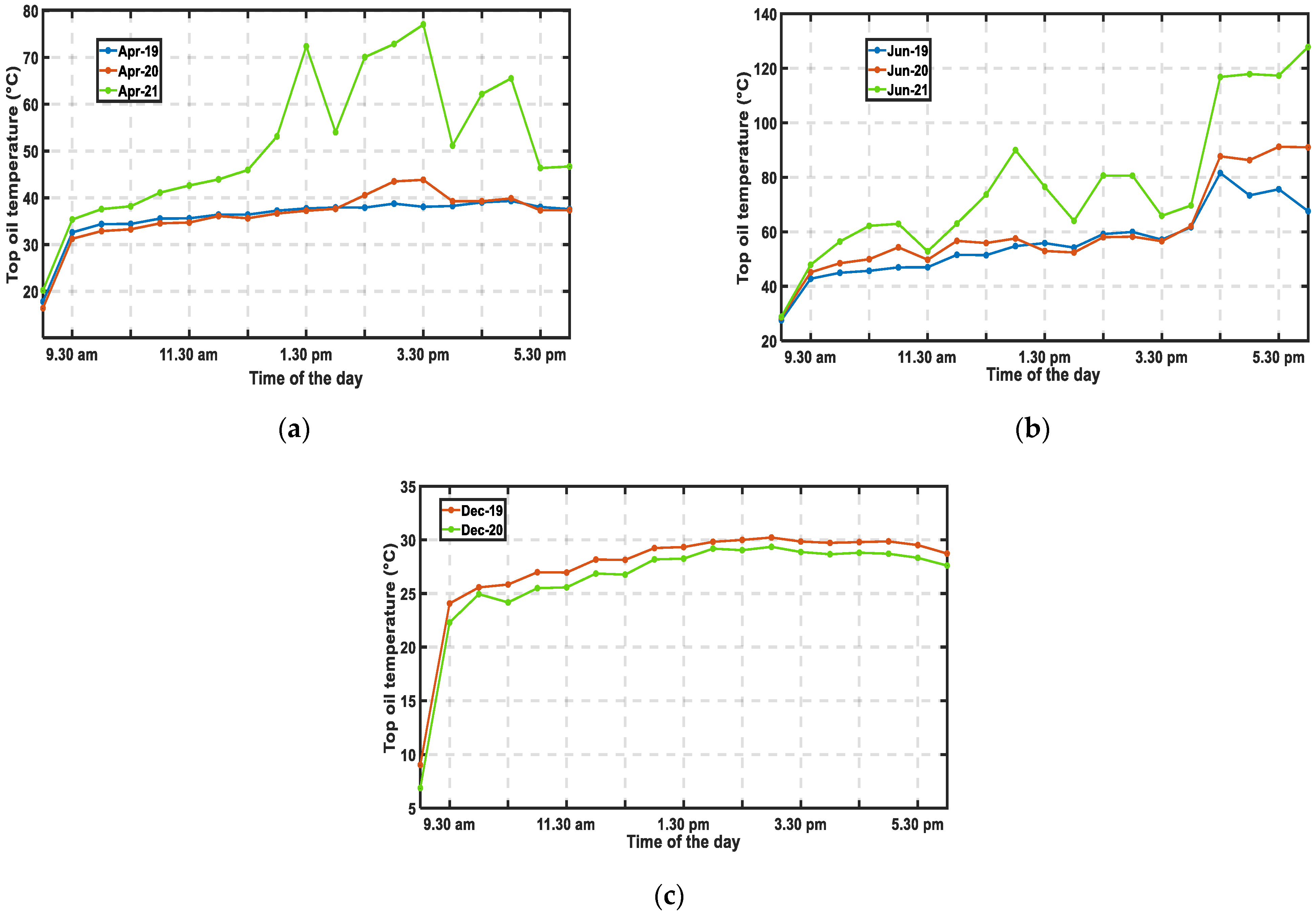
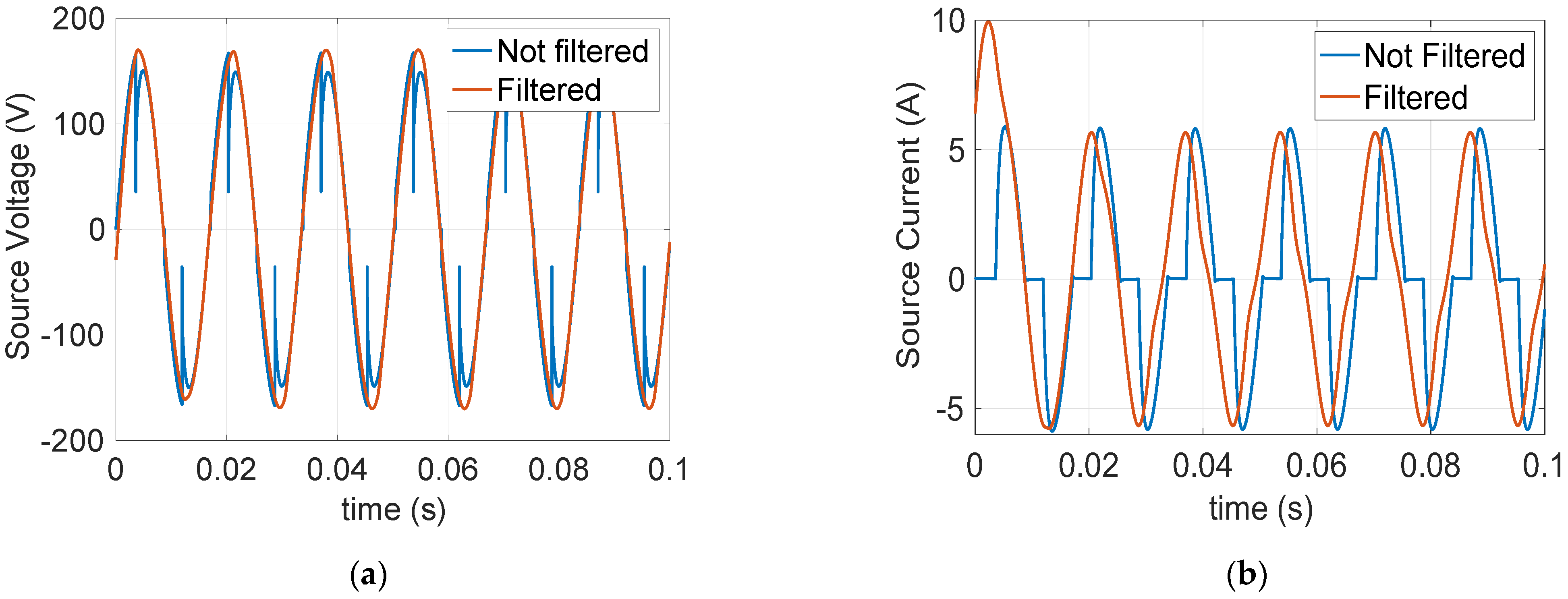
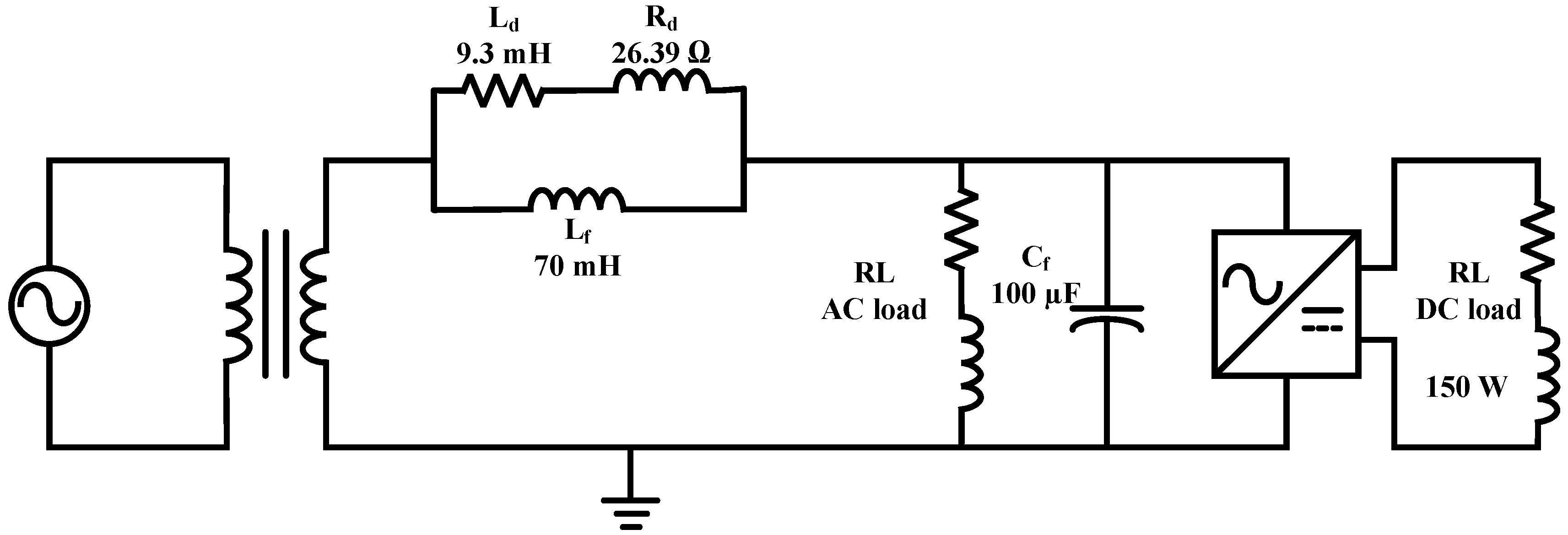



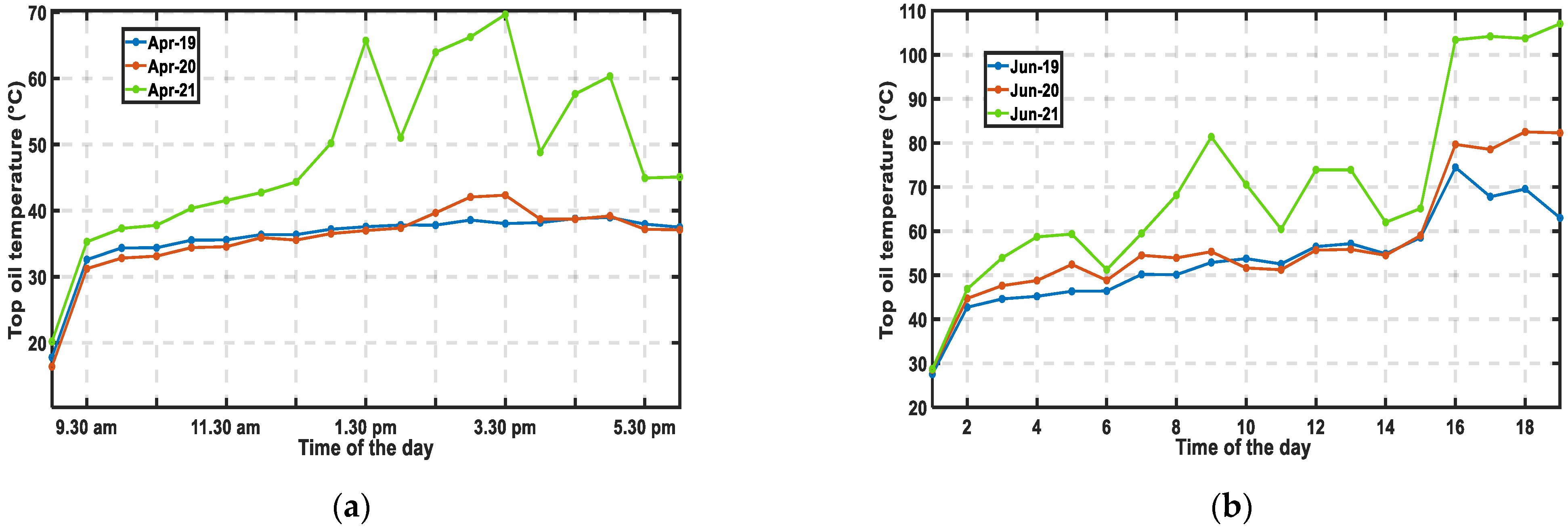

| Time | Months | |||||||||||
|---|---|---|---|---|---|---|---|---|---|---|---|---|
| Jan | Feb | Mar | Apr | May | Jun | Jul | Aug | Sep | Oct | Nov | Dec | |
| 9:00 a.m. | 0.25 | 0.50 | 0.00 | 0.25 | 0.50 | 0.50 | 0.50 | 0.50 | 0.25 | 0.50 | 0.00 | 0.50 |
| 9:30 a.m. | 0.75 | 0.50 | 0.00 | 0.50 | 0.75 | 0.75 | 0.50 | 0.25 | 0.00 | 0.50 | 0.00 | 0.75 |
| 10:00 a.m. | 0.25 | 0.50 | 0.00 | 0.75 | 1.00 | 0.75 | 0.50 | 0.00 | 0.25 | 0.25 | 0.50 | 0.75 |
| 10:30 a.m. | 0.75 | 0.50 | 0.00 | 0.75 | 1.00 | 0.75 | 0.50 | 0.00 | 0.25 | 0.50 | 0.75 | 0.75 |
| 11:00 a.m. | 0.50 | 0.75 | 0.00 | 0.75 | 0.75 | 0.5 | 0.75 | 0.50 | 0.25 | 0.75 | 0.75 | 0.75 |
| 11:30 a.m. | 0.75 | 0.50 | 0.00 | 0.75 | 0.50 | 0.75 | 0.50 | 0.50 | 0.25 | 0.25 | 0.75 | 0.75 |
| 12:00 p.m. | 0.75 | 0.50 | 0.25 | 0.75 | 0.75 | 0.75 | 0.75 | 0.25 | 0.25 | 0.75 | 0.75 | 0.50 |
| 12:30 p.m. | 0.75 | 0.50 | 0.50 | 0.75 | 0.75 | 1.00 | 0.75 | 0.25 | 0.25 | 0.75 | 1.00 | 0.75 |
| 1:00 p.m. | 0.50 | 0.75 | 0.00 | 1.00 | 0.75 | 0.75 | 0.75 | 0.75 | 0.00 | 0.75 | 1.00 | 0.75 |
| 1:30 p.m. | 0.75 | 0.50 | 0.25 | 0.75 | 1.00 | 0.50 | 0.75 | 0.50 | 0.25 | 0.50 | 0.75 | 0.75 |
| 2:00 p.m. | 0.50 | 0.75 | 0.75 | 1.00 | 0.75 | 0.75 | 0.75 | 0.25 | 0.00 | 0.50 | 0.75 | 0.75 |
| 2:30 p.m. | 0.75 | 0.75 | 0.50 | 1.00 | 0.75 | 0.75 | 0.50 | 0.25 | 0.00 | 1.00 | 0.75 | 0.75 |
| 3:00 p.m. | 0.75 | 0.50 | 0.25 | 1.00 | 1.00 | 0.50 | 0.50 | 0.75 | 0.00 | 0.75 | 0.25 | 0.50 |
| 3:30 p.m. | 0.50 | 0.00 | 0.25 | 0.75 | 0.75 | 0.50 | 0.75 | 0.25 | 0.00 | 0.00 | 0.50 | 0.25 |
| 4:00 p.m. | 0.00 | 0.25 | 0.50 | 1.00 | 0.50 | 1.00 | 0.50 | 0.25 | 0.25 | 0.75 | 1.00 | 0.25 |
| 4:30 p.m. | 0.75 | 1.00 | 0.25 | 1.00 | 0.50 | 1.00 | 0.50 | 0.25 | 0.00 | 0.50 | 0.75 | 0.75 |
| 5:00 p.m. | 0.50 | 0.75 | 0.25 | 0.50 | 0.75 | 1.00 | 0.50 | 0.50 | 0.00 | 0.50 | 0.25 | 0.50 |
| 5:30 p.m. | 0.25 | 0.50 | 0.25 | 0.50 | 0.50 | 1.00 | 0.50 | 0.25 | 0.00 | 0.50 | 0.50 | 0.50 |
| 6:00 p.m. | 0.50 | 0.25 | 0.25 | 0.75 | 0.75 | 0.75 | 0.75 | 0.50 | 0.00 | 0.25 | 0.75 | 0.75 |
| Time | April | June | ||||
|---|---|---|---|---|---|---|
| 2019 | 2020 | 2021 | 2019 | 2020 | 2021 | |
| 9:00 a.m. | 0.02 | 0.03 | 0.05 | 0.04 | 0.17 | 0.26 |
| 9:30 a.m. | 0.04 | 0.06 | 0.14 | 0.17 | 0.26 | 0.46 |
| 10:00 a.m. | 0.05 | 0.11 | 0.17 | 0.19 | 0.29 | 0.56 |
| 10:30 a.m. | 0.04 | 0.10 | 0.24 | 0.23 | 0.43 | 0.62 |
| 11:00 a.m. | 0.05 | 0.11 | 0.30 | 0.19 | 0.24 | 0.33 |
| 11:30 a.m. | 0.04 | 0.12 | 0.31 | 0.35 | 0.44 | 0.55 |
| 12:00 p.m. | 0.04 | 0.07 | 0.36 | 0.32 | 0.41 | 0.69 |
| 12:30 p.m. | 0.05 | 0.08 | 0.43 | 0.40 | 0.46 | 0.99 |
| 1:00 p.m. | 0.12 | 0.14 | 0.88 | 0.44 | 0.35 | 0.82 |
| 1:30 p.m. | 0.09 | 0.12 | 0.47 | 0.36 | 0.29 | 0.53 |
| 2:00 p.m. | 0.07 | 0.26 | 0.78 | 0.49 | 0.46 | 0.83 |
| 2:30 p.m. | 0.13 | 0.35 | 0.80 | 0.52 | 0.47 | 0.86 |
| 3:00 p.m. | 0.04 | 0.38 | 0.94 | 0.45 | 0.42 | 0.62 |
| 3:30 p.m. | 0.05 | 0.21 | 0.42 | 0.46 | 0.44 | 0.52 |
| 4:00 p.m. | 0.12 | 0.20 | 0.64 | 0.88 | 0.93 | 1.25 |
| 4:30 p.m. | 0.18 | 0.26 | 0.77 | 0.74 | 0.90 | 1.27 |
| 5:00 p.m. | 0.08 | 0.11 | 0.36 | 0.80 | 0.96 | 1.24 |
| 5:30 p.m. | 0.06 | 0.11 | 0.30 | 0.69 | 1.01 | 1.37 |
| 6:00 p.m. | 0.14 | 0.25 | 0.67 | 0.54 | 0.74 | 1.38 |
| Case 1 | Case 2 | Case 3 | Case 4 | Case 5 | Case 6 | Case 7 | Case 8 | |
|---|---|---|---|---|---|---|---|---|
| With RLC | With RLC | With RLC | With RLC | W/O RLC | W/O RLC | W/O RLC | W/O RLC | |
| Readings | With RL | Without RL | With RL | Without RL | With RL | Without RL | With RL | Without RL |
| V(AC) (RMS) | 120.6 | 120.5 | 121.39 | 121.6 | 119.5 | 119.97 | 120.32 | 121.4 |
| I(AC) (RMS) | 3.4 | 3.28 | 2.82 | 2.8 | 4.76 | 4.2 | 2.56 | 2.16 |
| V(DC) | 63.3 | 66.4 | 40 | 40 | 95.2 | 94.1 | 40 | 40 |
| I(DC) | 2.45 | 2.58 | 1.55 | 1.55 | 3.68 | 3.64 | 1.55 | 1.55 |
| THD% | 6.50 | 6.60 | 16.80 | 20 | 9.60 | 11.00 | 45.50 | 56.20 |
| Month | Year | Without Filter (%) | With Filter (%) | Reduction in Loss of Life (%) |
|---|---|---|---|---|
| April | 2019 | 2.10 × 10−7 | 1.94 × 10−7 | 7.55 |
| 2020 | 9.78 × 10−7 | 5.96 × 10−7 | 39.04 | |
| 2021 | 1.11 × 10−2 | 1.87 × 10−3 | 83.12 | |
| June | 2019 | 0.009 | 0.002 | 81.75 |
| 2020 | 0.131 | 0.020 | 85.06 | |
| 2021 | 36.728 | 2.515 | 93.15 | |
| December | 2019 | 5.19 × 10−8 | 4.86 × 10−8 | 6.37 |
| 2020 | 5.02 × 10−8 | 4.53 × 10−8 | 9.80 |
Disclaimer/Publisher’s Note: The statements, opinions and data contained in all publications are solely those of the individual author(s) and contributor(s) and not of MDPI and/or the editor(s). MDPI and/or the editor(s) disclaim responsibility for any injury to people or property resulting from any ideas, methods, instructions or products referred to in the content. |
© 2023 by the authors. Licensee MDPI, Basel, Switzerland. This article is an open access article distributed under the terms and conditions of the Creative Commons Attribution (CC BY) license (https://creativecommons.org/licenses/by/4.0/).
Share and Cite
Alam, S.M.M.; Abuhussein, A.; Sadi, M.A.H. Month-Wise Investigation on Residential Load Consumption Impact during COVID-19 Period on Distribution Transformer and Practical Mitigation Solution. Energies 2023, 16, 2294. https://doi.org/10.3390/en16052294
Alam SMM, Abuhussein A, Sadi MAH. Month-Wise Investigation on Residential Load Consumption Impact during COVID-19 Period on Distribution Transformer and Practical Mitigation Solution. Energies. 2023; 16(5):2294. https://doi.org/10.3390/en16052294
Chicago/Turabian StyleAlam, S. M. Mahfuz, Ahmed Abuhussein, and Mohammad Ashraf Hossain Sadi. 2023. "Month-Wise Investigation on Residential Load Consumption Impact during COVID-19 Period on Distribution Transformer and Practical Mitigation Solution" Energies 16, no. 5: 2294. https://doi.org/10.3390/en16052294
APA StyleAlam, S. M. M., Abuhussein, A., & Sadi, M. A. H. (2023). Month-Wise Investigation on Residential Load Consumption Impact during COVID-19 Period on Distribution Transformer and Practical Mitigation Solution. Energies, 16(5), 2294. https://doi.org/10.3390/en16052294










